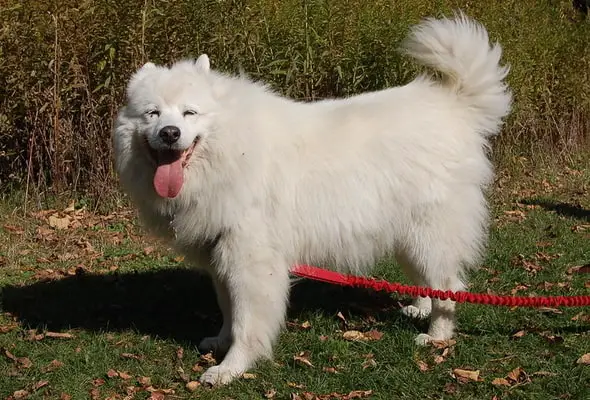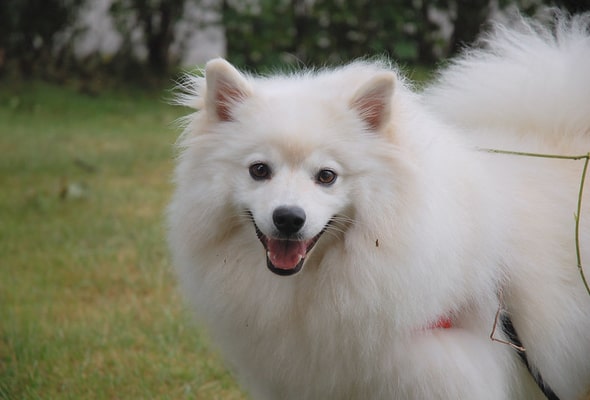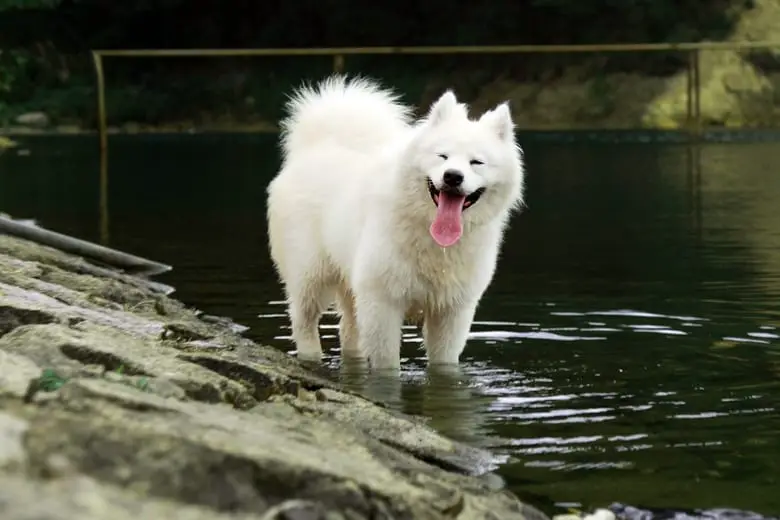Huskies are most well-known for their incredible sled-pulling abilities, but they’re not all work!
They are excellent working dogs, having been bred to assist the Chukchi people of Siberia in hunting more efficiently, but they are also seriously sweet, friendly, and loyal cuddle bugs. They’re undeniably a beautiful breed of dogs, but there are some white dogs that look like Huskies that come close.
Let’s see what they are!
The Types of White Dogs That Look Like Huskies
There are hundreds of dog breeds in the world, and they’re all special in some way. While some are really different, the two breeds that are closest to Huskies in looks are Samoyed and American Eskimo.
1. Samoyed

Standard Height: 19-23.5 inches
Standard Weight: 35-65 pounds
Coat Color: Most commonly pure white
Samoyed is a substantial but graceful dog standing anywhere from 19 to a bit over 23 inches at the shoulder. Powerful, tireless, with a thick all-white coat impervious to cold, Samoyed are perfectly beautiful but highly functional.
Their most delightful feature, a perpetual smile, has a practical function: The upturned corners of the mouth keep Sammies from drooling, preventing icicles from forming on the face.
History
The name Samoyed is derived from the Samoyedic people (also known as Samoyedic people), a semi-nomadic people from Asia who migrated to Siberia a thousand years ago. They bred dogs for hard work in the world’s coldest inhabited areas.
During the Arctic nights, the Samoyed people lived in tents and huddled for warmth with their dog packs. Samoyed dogs and people developed a strong bond as a result of this type of human-canine cooperation for mutual survival.
Samoyed dogs earned their keep as watchdogs and hunters when they weren’t sledging heavy loads across vast swaths of Siberia. Reindeer served as a vital source of food, fur, and leather for the Samoyed.
Initially, they hunted reindeer with their dogs. However, Samoyed culture evolved from reindeer hunting to reindeer herding over time. The fearless white hunting and hauling dogs took on a new role as stock dogs, moving and protecting the herds.
Breed Snapshot
Ears: Samoyeds have strong, thick and triangular ears that are a bit rounded at the tips.
Eyes: Deep and dark, their eyes are placed well apart and are almond-shaped with dark eye rims.
Nose: They usually have a black nose, which can sometimes be dark brown. Nose color can change with age and weather.
Tail: Their tail is moderately long and covered with thick hair. It shouldn’t be high or low set, and it should move freely over their back.
Coat Length: Samoyeds are double-coated dogs. They have an undercoat of soft, short, thick, close wool with longer, coarser hair growing through it.
Personality
Samoyed is a friendly, personable dog. These are intelligent dogs, with a touch of independence. Bred to live in a tent in very close quarters with their families, they thrive on human company.
Samoyeds will alarm bark and, if left alone for long periods of time, will often develop into nuisance barkers. Digging can be a problem because they dig to reach a cool resting place. Samoyeds tend to get along well with other dogs as well as people and with other pets they are raised with. They are herding dogs and may show some tendency to chase or nip.
In general, they get along well with children, although they can be a little boisterous for small toddlers.
Living With
Samoyeds are a breed that are extremely easy to care for, requiring only a small amount of high-quality food to thrive. Obesity can easily develop as a result of too many treats or insufficient exercise. Samoyeds are hardy, long-lived dogs that can live to be 12 or 14 years old.
These are energetic dogs who require daily exercise. Samoyeds enjoy training and will gladly compete in obedience, agility, herding, sledding, and weight pulls because they are so attuned to people.
When left alone for long periods of time, they do not thrive. Samoyeds usually bark to alert strangers before greeting them with a wagging tail and tongue. The distinctive “Sammie smile” with the curved lips is not an expression of aggression in any way.
Samoyeds can be independent, so early training and socialization with a firm but gentle hand is recommended. They thrive when given tasks to complete, even if it’s just pulling a cart in a parade. Grooming should be done at least once a day, especially during shedding season.
2. American Eskimo

Standard Height: 15-19 inches
Standard Weight: 25-35 pounds
Coat Color: A beautiful pure white coat
American Eskimo is a small to medium-sized Nordic-type dog that resembles Siberian Huskies in appearance very closely. Toy, miniature, and standard are the three types. They have erect, triangular ears and a thickly plumed tail curled over its back.
It has a well-carried neck and a good, level topline. The Eskie can trot with bold, energetic action thanks to its strong legs and feet, and is definitely a white dog that looks like a husky.
History
American Eskimo dogs descend from the ancient spitz family of dogs. In fact, this breed is the one many people think of when they think of a spitz. Typical of the spitz family, they have many features to combat cold weather, including a thick coat, small ears, and a bushy tail to warm the nose when curled up sleeping.
They probably were developed from spitz-type dogs in Germany, with input from other spitz breeds such as the Pomeranian, Volpino Italiano, and Keeshond.
In fact, it was the exclusion of white Keeshonden and oversize Pomeranians in the early 1900s that produced a population of dogs that probably played a large role in establishing the American Eskimo dog.
These dogs were general farm dogs and watchdogs, and they often accompanied their owners to America. The United Kennel Club recognized the breed in 1913 as the American spitz. In the 1920s, the breed gained fame as a circus dog, and many circuses sold puppies on the side. Old pedigrees included information on what tricks each ancestor could do.
After World War I, the breed’s name was changed to the less Germanic-sounding American Eskimo.
Breed Highlights
Ears: American Eskimo ears are small, upright and triangular with slightly blunted tips.
Eyes: Their eyes have a slight oval shape, are medium-sized and dark brown. Their eye rims are also dark brown or black, but their eyelashes are snow-white!
Nose: They have broad muzzle and a nose that is either dark brown or black.
Tail: The American Eskimo has a high-set tail that is long and fluffy.
Coat Length: American Eskimo Dogs have a fluffy double coat. (A dog with a double coat has two layers of coats: The undercoat is typically dense and more “wooly” and regulates body temperature.
Personality
The American Eskimo is a family dog. Eskies are very loyal and need to be around their owners. They are highly intelligent, but can be stubborn. They make good watchdogs, but are prone to excessive barking. They must be socialized with people or they can become overly wary of strangers.
With proper socialization along with a proper introduction, Eskies warm up to strangers and accept them good-naturedly. An Eskie only needs a moderate amount of exercise, but needs plenty of things to do, or it will find something to do.
Like all intelligent dogs, they can become bored and may dig or chew in an effort to entertain themselves. These dogs are smart and capable of Houdini-like escapes if not properly confined.
Living With
American Eskimos dogs need to interact with their owners. They tolerate other dogs and household cats well, if raised with them. As with most breeds, especially Nordic breeds, other pets, such as rodents, birds and reptiles, should be kept away from the Eskie.
Eskies make excellent watchdogs and are suspicious of strangers, but their size does not make for a good deterrent. Some Eskies can bark excessively if not properly trained. Eskies are ideal for people who want a small to medium-sized active dog that does not require a large yard and can be content with walks and games of fetch.
Eskies do not do well left alone for long periods. An Eskie typically lives from 10 to 15 years.

